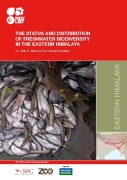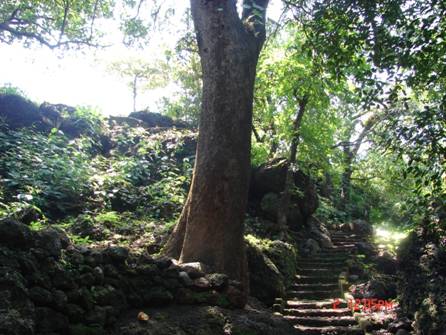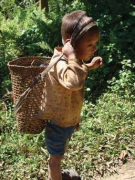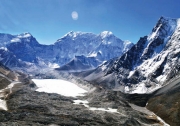/regions/physiography
Physiography
The status and distribution of freshwater biodiversity in the eastern Himalaya – A report by IUCN
Posted on 28 Jan, 2011 07:08 AM One of the main reasons cited for inadequate representation of biodiversity is a lack of readily available information on the status and distribution of inland water taxa.
One of the main reasons cited for inadequate representation of biodiversity is a lack of readily available information on the status and distribution of inland water taxa.
In response to this need for information, the IUCN Species Programme, in collaboration with Zoo Outreach Organisation (ZOO) conducted the Eastern Himalaya Freshwater Biodiversity Assessment, a review of the global conservation status of 1,073 freshwater species belonging to three taxonomic groups – fishes (520 taxa), molluscs (186 taxa), and odonata (dragonflies and damselflies) (367 taxa).
Other groups that include freshwater species that have been comprehensively assessed are freshwater crabs (assessed in 2008, and 57 species of crab are present within the assessment region), mammals, birds, and amphibians and their assessments can be accessed on the IUCN Red List.
Geo-hydrological studies for augmentation of spring discharge in the Western Himalaya – Final technical report by the MOWR
Posted on 23 Jan, 2011 04:39 PMIt is an attempt to understand the effect of rainfall, physiography, lithology, slope and aspect, land use practices, vegetation, altitude, soil type and anthropogenic interference (e.g., road construction and settlement etc.) and other characteristics in the spring recharge zone on the water yield and water quality of the selected springs in the mid-altitudinal belt (lesser Himalaya) in western Himalaya (Uttaranchal).
Sustainable water management initiatives in Konkan under threat - A report
Posted on 21 Jan, 2011 02:09 PMGuest Post by: Parineeta Dandekar
At the first sight, Daarche Paani (‘water at the doors’) appears unreal.. on a small flat plateau called ‘Sadaa’ in konkan, an elegant cobbled walkway leads a puzzled visitor to stairs carved in stone, which go down to an ancient grove, and here is an intricate system of tanks, channels and falls which supplies water to the Panderi village and goes down as a free flowing stream, to irrigate a plantation of arecanut, pepper and mangoes in a village called Gudaghe. When I visited the place, I could see three eminent visitors, a silent lady washing her load of clothes, a fairy bluebird splashing at a tank and a huge moonmoth in one of the trees.
 Stone walkway and ancient mango trees leading to Daarche Paani.
Stone walkway and ancient mango trees leading to Daarche Paani.
Photo: Parineeta Dandekar
Annual climate summary of India during 2010 - Press release by India Meteorological Department
Posted on 17 Jan, 2011 12:06 PMContent courtesy: Indian Meteorological Department
Mean annual temperature for the country as a whole during 2010 was +0.93 0C above the 1961-1990 average. It was slightly higher than that of the year 2009, thus making the year 2010 as the warmest year on record since 1901.
Considering different seasons, Pre-Monsoon season (March-May) in 2010 was the warmest since 1901 with mean temperature being 1.8 0C above normal
The annual total rainfall for the country as a whole was normal during the year 2010 with actual rainfall of 121.5 cm against the long period average (LPA) of 119.7 cm.
Saltscapes - Dholavira, Gujarat - A guest post by Amitangshu Acharya and Ayan Ghosh
Posted on 27 Dec, 2010 11:41 PMGuest Post: Text by Amitangshu Acharya, Photographs by Ayan Ghosh
Kachchh – a brilliant halfway between a turmeric yellow Rajasthan and the emerald green Sahyadris – offers an upside down version of life. It tells you that seeds of life and civilisation are often hidden beneath the sands of time in inhospitable terrains.
"Jungle Trees of Central India" - A preview of the field guide for tree-spotters by Pradip Krishen
Posted on 23 Dec, 2010 01:26 AM
Content Courtesy: Flowers of India
Jungle Trees of Central India is a lovingly detailed field guide to every tree you're likely to see in the magnificent dry, deciduous forests of the region. Bigger than France and encompassing 5 of India's most visited Tiger Reserves, Central India is home to the classical types of wilderness that one associates with the term 'Indian Jungle'.
Climate change impacts, mitigation and adaptation - Science for generating policy options in Rajasthan
Posted on 20 Dec, 2010 09:14 PM This paper by Rajasthan Pollution Control Board on climate change impacts in the context of Rajasthan seeks to address the issue of need of the society for robust knowledge to pursue strategies for mitigation as well as adaptation in order to address the challenges associated with global warming and climate change.
This paper by Rajasthan Pollution Control Board on climate change impacts in the context of Rajasthan seeks to address the issue of need of the society for robust knowledge to pursue strategies for mitigation as well as adaptation in order to address the challenges associated with global warming and climate change.
Accordingly, here a brief review of the available literature and an annotated bibliography of published research on climate change impacts, mitigation and adaptation in order to facilitate the identification of policy options in Rajasthan is provided.
Also included is the literature on how human societies contribute to environmental change and how, in turn, become vulnerable to these changes. It also explores the available knowledge on how likely ecosystem goods and services are impacted to climatic oscillations (environmental sensitivity) and the ability of rural communities to cope (social resilience) with those changes.
Water poverty in the northeastern hill region of India: Potential alleviation through multiple-use water systems - A report by IWMI
Posted on 20 Dec, 2010 12:07 AM This study by IWMI maps the household water poverty in a typical remote village of the northeast, understands the causes for such a scenario and reflects on the past efforts. Local water resource-based multiple-use water systems that provide water supply both for household and livestock needs and for small high-value agriculture are understood.
This study by IWMI maps the household water poverty in a typical remote village of the northeast, understands the causes for such a scenario and reflects on the past efforts. Local water resource-based multiple-use water systems that provide water supply both for household and livestock needs and for small high-value agriculture are understood.
The per capita and per hectare availability of water in India is highest in this region but the societal (both productive and consumptive) water use is less than five per cent of the existing potential. The unutilised and excessive water supplies during the rainy season create a mayhem of devastations almost every year with ravaging floods, landslides, soil erosion and other infrastructural failures and miseries and unrest in large parts.
Formation of glacial lakes in the Hindu Kush-Himalayas and Glacial Lake Outburst Flood risk assessment - A report by ICIMOD
Posted on 19 Dec, 2010 05:17 PM This report by ICIMOD contains an assessment of the threat facing the Hindu Kush-Himalayan region from the recent (post-1950s) and rapid formation of meltwater lakes on the surface or at the end of a large number of the region’s glaciers owing to current climate warming. Individual case studies of the catastrophic outburst (glacial lake outburst floods or GLOFs) from such glacial lakes are introduced.
This report by ICIMOD contains an assessment of the threat facing the Hindu Kush-Himalayan region from the recent (post-1950s) and rapid formation of meltwater lakes on the surface or at the end of a large number of the region’s glaciers owing to current climate warming. Individual case studies of the catastrophic outburst (glacial lake outburst floods or GLOFs) from such glacial lakes are introduced.
Himalayi Jan Goshnapatra: Himalayi Niti Ka Prarup – A report in Hindi by the Gandhi Peace Foundation
Posted on 18 Dec, 2010 08:19 AMThis document in Hindi prepared by the Gandhi Peace Foundation, is a blueprint of the Himalayan People's Manifesto. The manifesto has been brought out with the help of various documents prepared by various people and organisations at different times. It will be finalised by the next Himalayan Day on September 9, 2011.